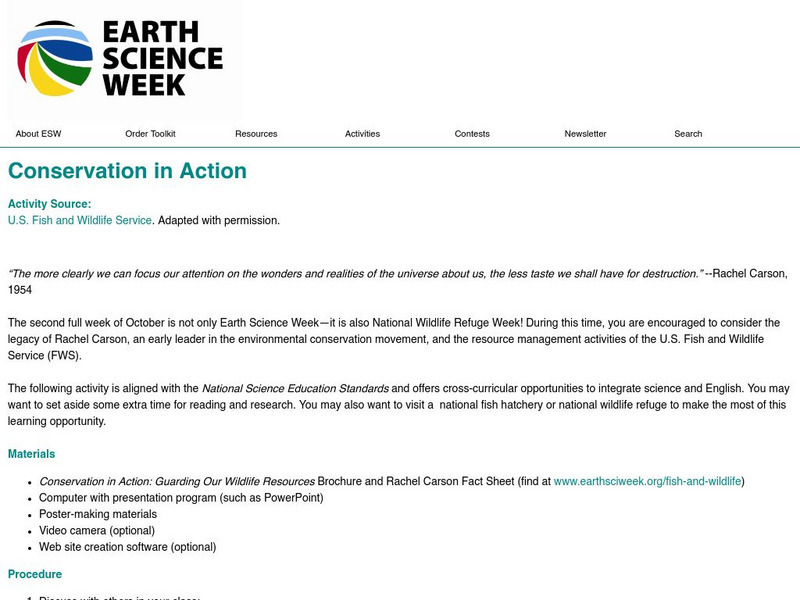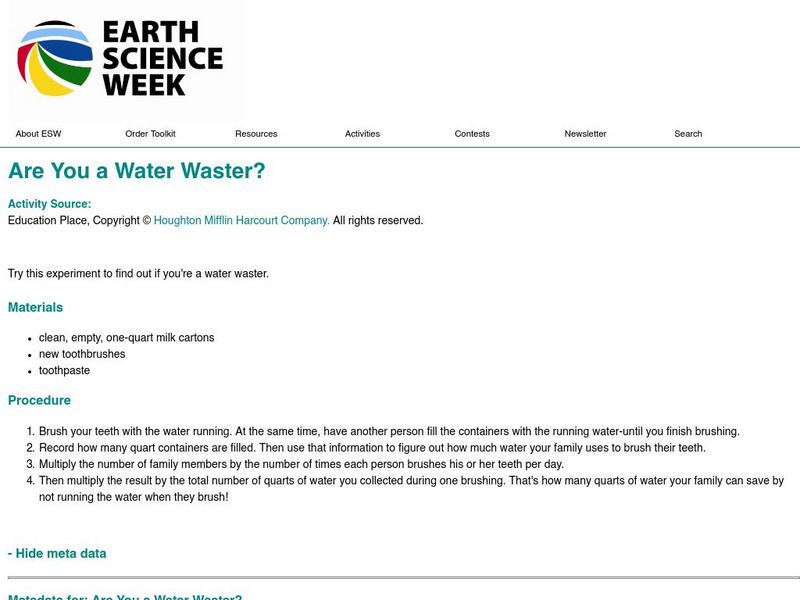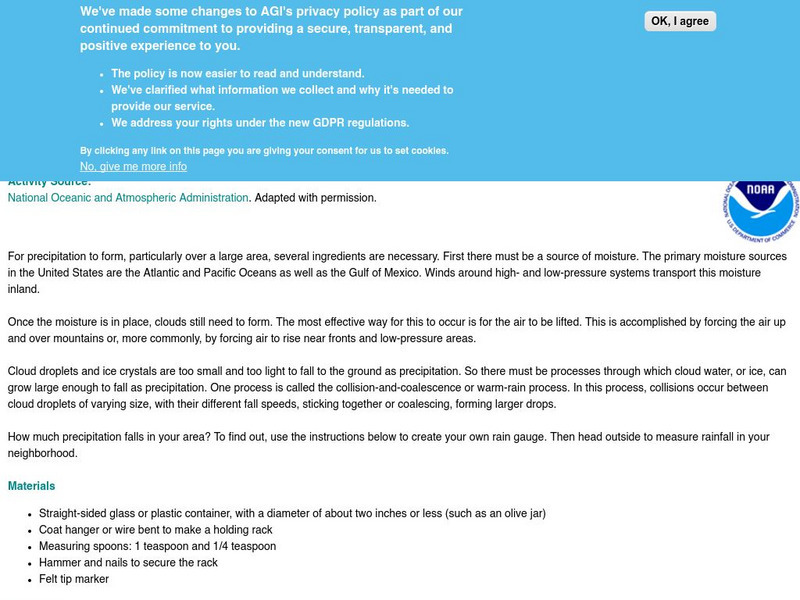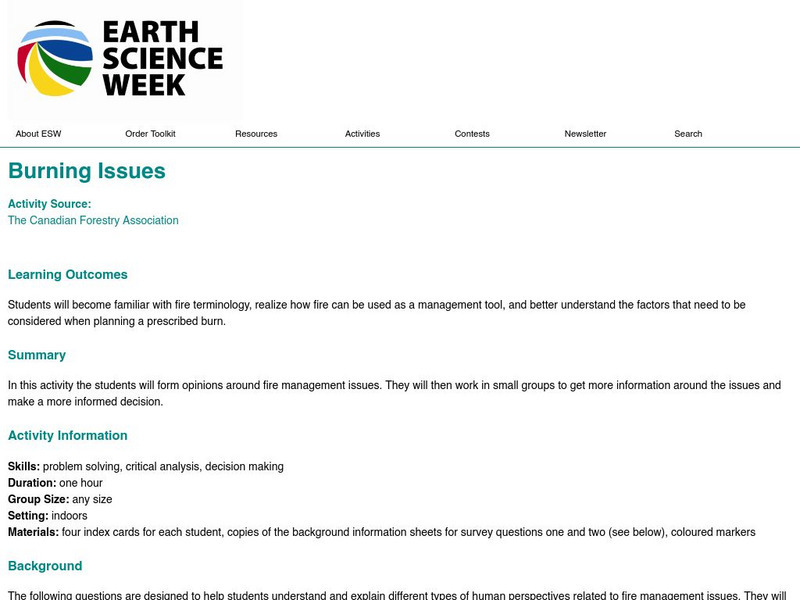American Geosciences Institute
American Geosciences Institute: Slideshows for the Series: Sustaining Our Soils and Society
This page contains a collection of PowerPoint slideshows that investigates soil. Explore what soil is, how it forms, why it is important, and how to sustain soil.
American Geosciences Institute
American Geosciences Institute: Slideshows for the Series: Water and the Environment
This page contains a collection of PowerPoint slideshows that explore water. Learn why water is important, why Earth is called the water planet, the parts of the water cycle, and the importance of water quality.
American Geosciences Institute
American Geosciences Institute: Wind Classroom Activities
When air is warmed, it expands and becomes less dense. As the air becomes less dense, its air pressure decreases. This occurs because molecules in warm air have greater kinetic energy (energy of motion) than in cold air. As the molecules...
American Geosciences Institute
American Geosciences Institute: Earth Science Week: Conservation in Action
A lesson where students study the legacy of Rachel Carson.
American Geosciences Institute
American Geosciences Institute: Earth Science Week: Constructive Forces of Mountain Building
Help students understand how mountains are formed with this lesson plan about constructive forces.
American Geosciences Institute
American Geosciences Institute: Earth Science Week: Core Sampling
Simulate core sampling with this instructional activity. Students will see layers of Earth with this activity.
American Geosciences Institute
American Geosciences Institute: Earth Science Week: Critical Zone
Explore the critical zone of Earth's surface in this lesson plan.
American Geosciences Institute
American Geosciences Institute: Earth Science Week: Engineer a Satellite
For this lesson, young scholars will construct a scale model of a satellite by researching what scientific instrument to put on it and how to power it.
American Geosciences Institute
American Geosciences Institute: Earth Science Week: Exploring Caves
A unit dedicated to teaching students about caves.
American Geosciences Institute
American Geosciences Institute: Earth Science Week: Energy and Population
Learn about how the population of a state is related to the energy consumed by studying these maps in this lesson plan.
American Geosciences Institute
American Geosciences Institute: Earth Science Week: Exploring Climate Change With Gis
Use Geographic Information System (GIS) technology to observe climate change with these interactive lessons.
American Geosciences Institute
American Geosciences Institute: Earth Science Week: Geologic Maps and Groundwater
This activity is designed to give students practice using a geologic map to understand how water shapes the land- and is stored within the land- in part of the Grand Canyon.
American Geosciences Institute
American Geosciences Institute: Earth Science Week: Know Your Energy Costs
The goal of this activity is to become aware of how much energy students use at school- and the financial and environmental costs.
American Geosciences Institute
American Geosciences Institute: Cold Front and Warm Front
Read and understand the differences between a cold and a warm front.
American Geosciences Institute
American Geosciences Institute: Earth Science Week: Exploring 'Wild' Places With Gis
This lesson plans uses Geographic information systems (GIS) technology to explore the local geography.
American Geosciences Institute
American Geosciences Institute: Earth Science Week: Exploring Color Maps
An activity where students study the Ozone Hole poster used that brings together colorful images of over 30 years of satellite observations of the ozone hole. Students interpret the color on the globes to see how the ozone hole has...
American Geosciences Institute
American Geosciences Institute: Earth Science Week: Finding Slope
A lesson plan that explores the importance of the slope of the soil to a soil's property. Understand how the soils slope affects many aspects of the property from the flow of water to planting.
American Geosciences Institute
American Geosciences Institute: Earth Science Week: Are You a Water Waster?
In this activity, students monitor how much water is used if the water is left running while they brush their teeth. They use that information to calculate how much the whole family would use. They learn how much water can be conserved...
American Geosciences Institute
American Geosciences Institute: Earth Science Week: Birdseed Mining
In this activity, students are given shallow pans with a mixture of birdseed and different colored beads. They must 'mine' the pan to extract seeds and beads, each of which is assigned a monetary value. They then calculate how much they...
American Geosciences Institute
American Geosciences Institute: Earth Science Week: Build a Rain Gauge
In this experiment, students build and calibrate a rain gauge and use it to measure and record how much rain falls in their local area each time it rains.
American Geosciences Institute
American Geosciences Institute: Earth Science Week: Build Your Own Weather Station
Students are guided in how to build their own weather station that will measure temperature, humidity, precipitation, atmospheric pressure, and wind direction and speed.
American Geosciences Institute
American Geosciences Institute: Earth Science Week: Burning Issues
In this activity, students will learn about fire management and research the questions of whether forest fires should always be extinguished and whether prescribed burns can be helpful. They will form and support their own opinions about...
American Geosciences Institute
American Geosciences Institute: Earth Science Week: Celebrate Wilderness
In this activity, students research a wilderness refuge near them or through online resources. They will investigate the history of a refuge and how indigenous people lived there long ago, as well as the lives of any descendants of these...
American Geosciences Institute
American Geosciences Institute: Earth Science Week: Chemistry of Burning
In this activity, students use pipe cleaners and foam balls to build a model of a hydrocarbon molecule. They then modify it to demonstrate the chemical reaction that happens when the hydrocarbon is burned.

























